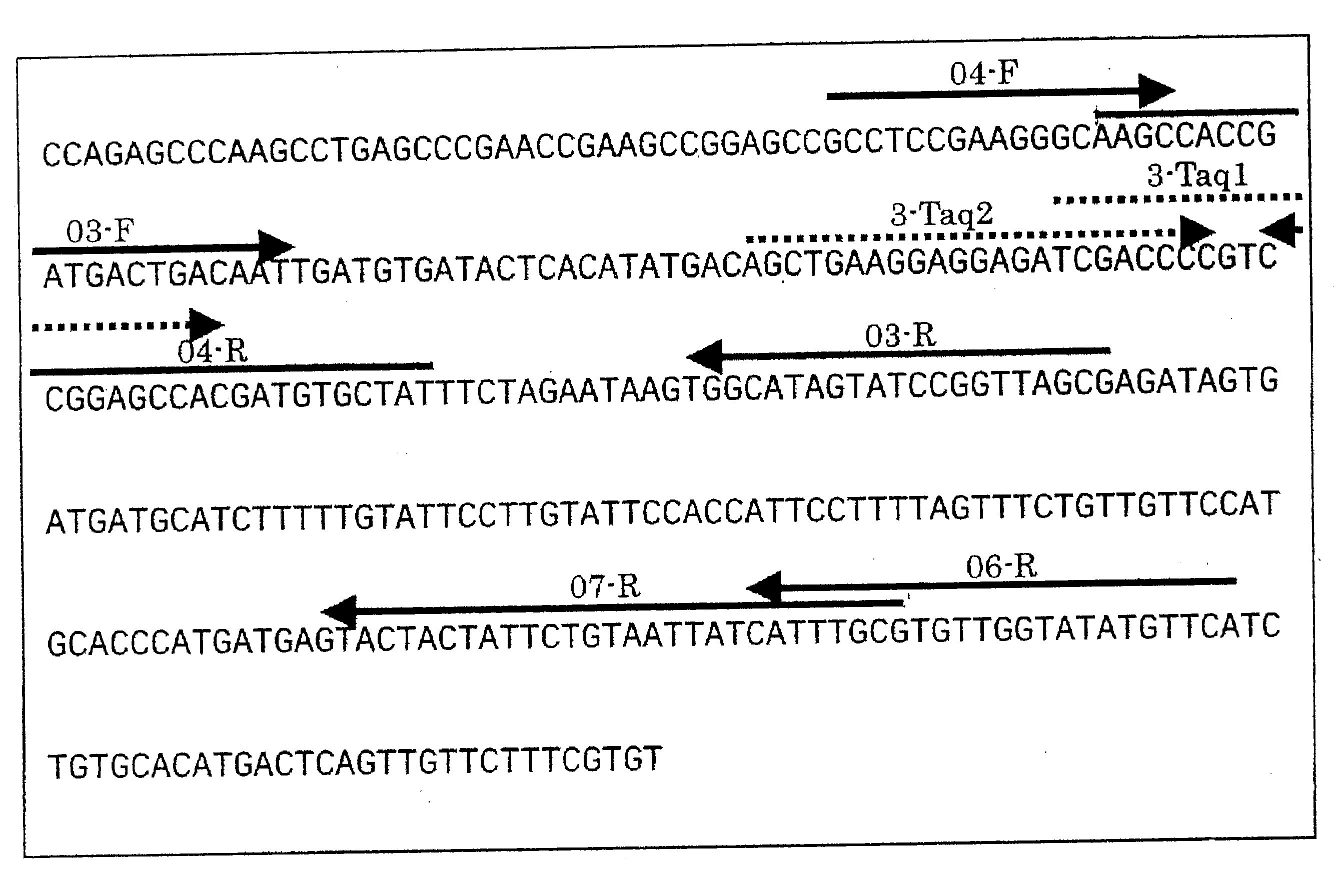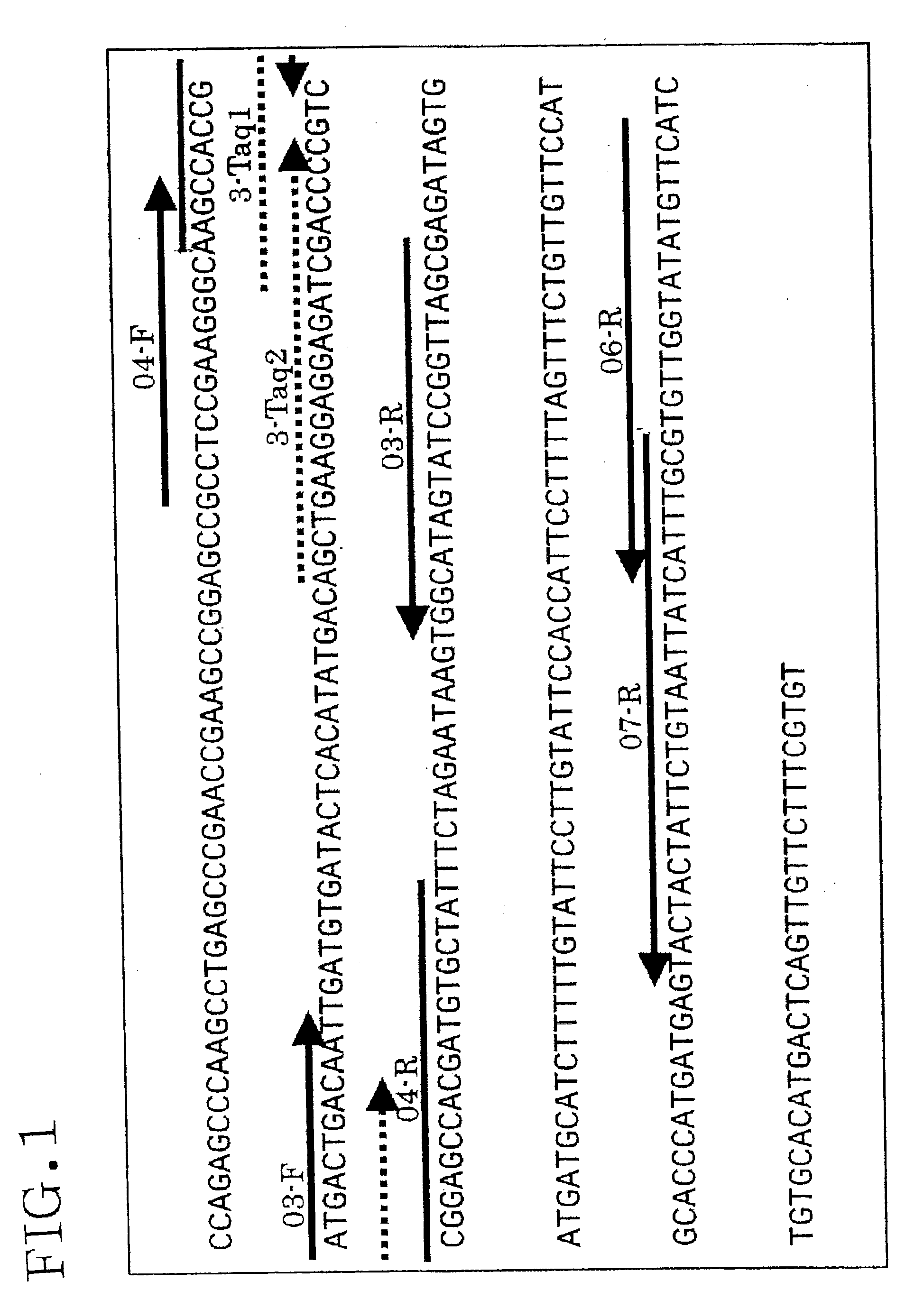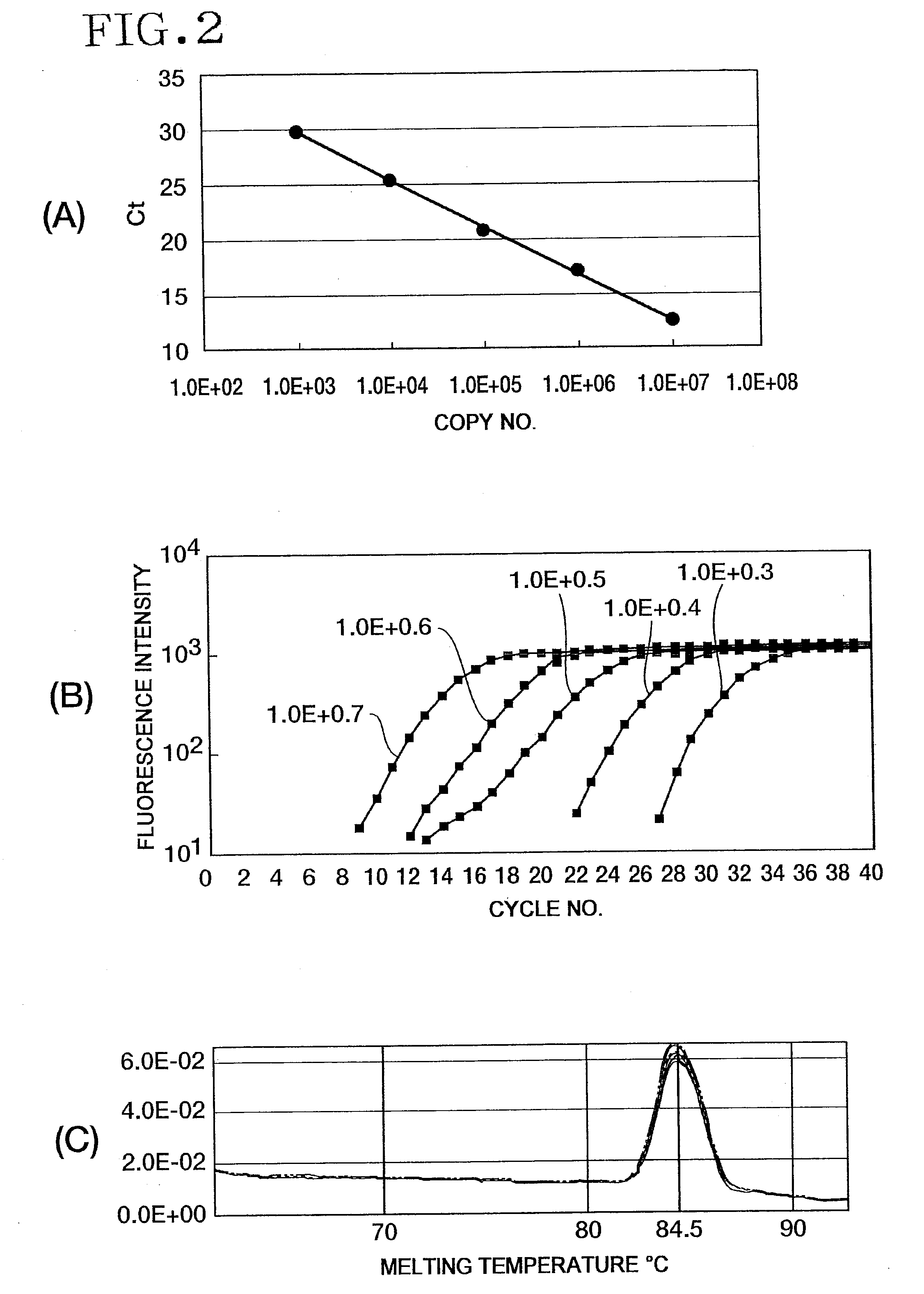Method of detecting or quantitating endogenous wheat DNA and method of determining contamination rate of genetically modified wheat in test sample
a technology of genetically modified wheat and dna quantification, which is applied in the field of detecting or quantifying endogenous wheat dna in a test sample, can solve the problem of inability to accurately assay endogenous wheat dna, and achieve the effect of detecting and quantifying endogenous wheat dna and determining the contamination rate of each gmo strain with good precision
- Summary
- Abstract
- Description
- Claims
- Application Information
AI Technical Summary
Benefits of technology
Problems solved by technology
Method used
Image
Examples
example 1
Plasmid Construction
[0140]Genomic DNA was extracted from grains of the Ernest cultivar of wheat, and PCR was performed using this DNA as a template. Table 1 shows the targets of amplification, and amplification was performed for two types of endogenous wheat gene candidates (PRP gene and Waxy gene), and for the RRS gene as a hypothetical GM wheat gene. Table 2 shows the primers that were used. As explained below, the RRS gene is a Roundup® resistant gene.
TABLE 1GeneGeneral NameSize (bp)PRPProline rich protein259WaxyWaxyD1529RRSEnolpymylshikimate phosphate synthase1886
TABLE 2AmpliconGeneNameSequencesizePRPprp04-F5′-GCCTCCGAAGGGCAAGC-3′ (SEQ ID NO: 5) 259 bpprp06-R5′-GAACATATACCAACACGCAAATG-3′ (SEQ ID NO: 6)RRSRRS-F5′-TGGAAAAGGAAGGTGGCTCCTAC-3′ (SEQ ID NO: 23)1919 bpRRS-R5′-GGGAATTGGATCCGGTACCGA-3′ (SEQ ID NO: 24)RRS Sac-F5′-AGAGCTCTGGAAAAGGAAGGTGGCTCCTAC-3′ (SEQ ID NO: 25)1926 bpRRS Sac-R5′-CGGAATTCGATCCGGTACCGA-3′ (SEQ ID NO: 26)WaxyWx-F5′-TTTTGTTGTGCCGCTTGCCT-3′ (SEQ ID NO: 27) 529...
example 2
Verification of PCR Amplification Rate
[0194]For the amplification regions of the PRP and Waxy genes, real-time PCR was performed by the SYBR procedure using the standard plasmid pWIG03 as a template. Template concentration-dependent amplification was observed for all genes and all PCR regions under the same conditions. According to the melting curves of the amplification products, each amplification product had a main peak having a high-melting point, and no formation of primer dimers was observed. FIG. 2 shows the amplification curve and melting curves. Table 10 shows a listing of the primer sequences used in Example 2 and thereafter.
TABLE 10Amplicon sizeGeneNameSequence(bp)PRPprp03-F5′-aag cca ccg atg act gac aat-3′ (SEQ ID NO: 3)231 (SEQ ID NO:prp07-R5′-cgc aaa tga taa tta cag aat agt agt ac-3′ (SEQ ID NO: 4)11)prp04-F5′-gcc tcc gaa ggg caa gc-3′ (SEQ ID NO: 5)244 (SEQ ID NO:prp07-R5′-cgc aaa tga taa tta cag aat agt agt ac-3′ (SEQ ID NO: 4)12)prp03-F5′-aag cca ccg atg act gac aat...
example 3
Search for Amplified Regions in PRP Gene
[0195]A search for regions in the PRP gene of which the detected quantity does not vary depending on the variety of wheat was made. The Waxy gene was used as a positive control, and a search for regions that give the detective amount equivalent of Wx012 amplified regions was made. The primer pairs used were: PRP01-F and PRP01-R, PRP03-F and PRP03-R, and PRP03-F and PRP07-R shown in Table 10. Real-time PCR was performed by the SYBR procedure using DNA extracted from wheat seeds as a template.
[0196]The results are shown in FIG. 3. When the primer pairs of PRP03-F and PRP03-R, and PRP03-F and PRP07-R were used, it was confirmed that the detected amount of PRP was approximately the same as that of Wx012. However, when PRP01-F and PRP01-R were used as primer, the detected amount was approximately three times larger than Wx012.
[0197]From this finding, it was confirmed that a gene homologous to PRP gene is present at the upstream region of the PRP ge...
PUM
| Property | Measurement | Unit |
|---|---|---|
| Fraction | aaaaa | aaaaa |
| Volume | aaaaa | aaaaa |
| Volume | aaaaa | aaaaa |
Abstract
Description
Claims
Application Information
 Login to View More
Login to View More - R&D
- Intellectual Property
- Life Sciences
- Materials
- Tech Scout
- Unparalleled Data Quality
- Higher Quality Content
- 60% Fewer Hallucinations
Browse by: Latest US Patents, China's latest patents, Technical Efficacy Thesaurus, Application Domain, Technology Topic, Popular Technical Reports.
© 2025 PatSnap. All rights reserved.Legal|Privacy policy|Modern Slavery Act Transparency Statement|Sitemap|About US| Contact US: help@patsnap.com



